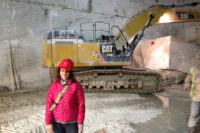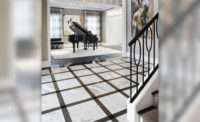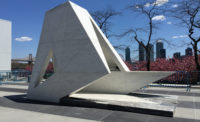“White marble is in demand,” said Luca Mannolini, general manager. “Danby has become a brand name. We are now getting requests from people around the world.”
Because of the growing popularity of Danby marble, Vermont Quarries has devoted time to research, development and investment in order to remain ahead of the curve. “In the U.S., white marble is catching on. People are using it for kitchens because they know that Danby has a low absorption, which is very important,” explained Todd Robertson, North American sales director. “We want to speed up delivery time and make it more efficient for our clients.”
Finding a viable source
A top priority for Vermont Quarries is to ensure it has secured a rich source of high-quality white marble. “It is important to research and do geological studies to find a viable source,” explained Mannolini. “You can spend millions of dollars on equipment, but it means nothing if you don’t have the marble.”
In 2007, the company opened the New Imperial/Norcross quarry, which sits 60 feet below the Upper Imperial Danby quarry. “The New Imperial Danby was opened because we needed another source of Imperial,” said Mannolini. At the time of Stone World’svisit, a second entrance to the Norcross quarry was being made, which Mannolini explained was required by the Mine Safety and Health Administration (MSHA).
Additionally, the Brook quarry, which had supplied Danby marble for many landmark buildings and monuments in Washington, DC, was re-opened in 2001. Today, it produces a selection of material, including Olympian White, Mountain White and Appalachian Green. The Imperial quarry produces the well-known Montclair, Royal, Eureka, Crystal Stratus, and of course, the majority of the company’s Imperial Danby.
The entire quarry sits on a 25-mile footprint and goes in 1½ miles in different directions. “We follow the vein of the marble,” said Mannolini.
In total, Vermont Quarries produces 1,500 to 2,000 metric tons of marketable blocks per month. On average, blocks measure 10 feet long x 5 to 6 feet high x 5 to 8 feet wide. For the slab market, the weight of the blocks range from 20 to 25 tons.
The quarry is equipped with three 988 H Cat block handlers to transport the heavy marble blocks. Additionally, four Fantini GU chainsaws and two Fantini floor chainsaws are in place to extract the marble. One of the floor chainsaws can operate a 5-meter blade. Recently, the company increased its workforce in the quarry to 35 employees because it started a second shift to keep up with the demand for its products.
Slab production
Inside the quarry, the company has a full production area set up for cutting slabs. “The unique thing about us is we quarry our own blocks and then cut our own slabs right here,” explained Robertson.
Blocks arrive on a 30-ton crane and then are moved to one of two Simec gangsaws — an 80 blade and newly added 50-blade saw. “We recently added the 50-blade gangsaw [in 2013] to help keep up with the demand,” said Robertson. “Having a second gangsaw also allows us to set up for a specific project and not disrupt the slabs being cut for our distributors. We also supply slabs from our sister company, Colorado Stone Quarries, and all of the Colorado materials produced, such as Calacatta Lincoln, Golden Vein and Statuary. Keeping up with the demand for these domestic white marbles is a constant battle.”
The gangsaws run two shifts. “Keeping up with the demand of our clients requires two shifts,” explained Robertson. “We know our distributors will take as much marble as we can produce. Our goal is to speed up production.”
With both gangsaws running, Vermont Quarries can produce between 8,000 to 10,000 square feet — or roughly 175 to 200 slabs from saw — per day. “That’s the demand,” said Robertson, adding that one shift takes between eight to 10 hours to cut a block. The company is looking to increase the capacity of the finishing process by adding a new polishing line.
Three months prior to Stone World’s visit, the company invested in a Bennetti mono wire saw, which allows it to cut custom sizes and thicknesses. The wire saw can cut up to 155 inches in length and 78 inches high, while a standard gangsaw can cut about 128 inches in length and 75 inches high. While the majority of slabs are cut to a thickness of 3 cm, some are cut at 2 cm and a little at 5 cm.
After the slabs are cut, they are moved to a Simec NP 2100 RX polishing line, which is capable of putting a polished, honed or brushed finish on 5,000 square feet a day. Once the slabs are off the polishing line, they are stacked, bundled and ready for shipment.
Two years ago, Vermont Quarries invested in a Prometec resin line, which is primarily used for vein-cut material. “Vein-cut is very popular and trendy right now,” said Mannolini. “Having a resin machine increases our yield of blocks.”
A growing brand
With the demand of white marble continuing to blossom, Vermont Quarries will continue to strategize and implement procedures and practices that will produce a high-quality product quickly. “We did a lot of investment,” said Mannolini. “The more you invest, the more you get back.”
According to Robertson, Vermont Quarries ships between 70,000 to 100,000 square feet of slabs a month to locations around the country — not counting custom jobs. “And the demand is growing,” he said. “We always have back orders.
“I see the demand going up and up,” Robertson went on to say, adding that the company also does a significant amount of commercial projects. “I travel around the country and talk to distributors. There are still so many people out there that don’t think white marble can be used in the kitchen. I like hearing that because that means there is still room for growth.”
Vermont Quarries has quite a few distributors — many in the New York Metropolitan area. “Some days we load three semi-trucks of slabs a day,” said Robertson. “The demand is just constant.”

























